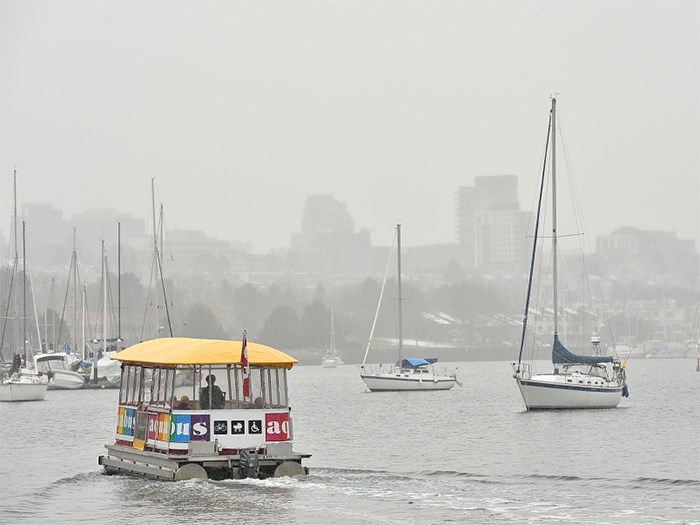 False Creek has long been a polluted waterway, partly because of sewage dumped by boaters. A city study conducted last year found that much of the seabed under major marinas in the creek were polluted with sewage from boats. Photo Dan Toulgoet
False Creek has long been a polluted waterway, partly because of sewage dumped by boaters. A city study conducted last year found that much of the seabed under major marinas in the creek were polluted with sewage from boats. Photo Dan Toulgoet
Will people be able to swim in False Creek this summer?
That was a question from Mayor Gregor Robertson and some city councillors Wednesday in discussing the city’s continued efforts to improve water quality in False Creek and penalize boaters guilty of flushing waste into the popular waterway.
The answer from Nick Page, a park board biologist, was not encouraging. He said the board and the city continue to work on developing a “hydraulic model” of the creek to better understand how water flows in and out of it, and how pollution moves within and out of the basin.
“I don’t think we can promise that we will have information from that hydraulic model to inform a decision around the swimming season,” Page told the mayor.
But the option of setting up a floating pool somewhere in the creek this summer, as was envisioned in a report council passed last June, has not been ruled out by city manager Sadhu Johnston.
“I don’t think, at this point, we’re ready to say we’re not meeting that aspirational target,” Johnston said. “It’s still something we’re looking into.”
Last summer, the city used divers to conduct underwater visual inspections of all the major marinas in False Creek. The study found that much of the seabed under the marinas is polluted with sewage from boats.
More recently, a Vancouver Coastal Health water quality report conducted in December showed the eastern part of False Creek near Science World, where there is limited tidal exchange, had an extremely high bacterial count.
The central and western parts of the creek had readings of 10 to 12 times lower, which is where Robertson suggested people might be able to swim this summer, if the health authority deems the area swimmable.
“The western parts of False Creek are swimmable some of the time,” he said, referring to areas off Granville Island, Yaletown and further west in False Creek.
Margot Davis, the city’s manager of environmental services, acknowledged “there are some areas [of False Creek] based on the data that could support swimmability closer to the ocean.” But Davis said there is more work to do before returning to council with details on whether those areas will be considered safe for swimming.
“We can work with the health authorities and see if there’s some kind of strategy around a particular area, and then also work to update you on where the floating pool initiative is at this time,” Davis said in response to the mayor.
The health authority’s water testing in December found that parts of English Bay, West Vancouver, North Vancouver and Richmond all recorded lower counts than the three areas of False Creek. The creek has long been lined with marinas and served as a popular spot for people to moor boats while vacationing, and others to stay put and live aboard.
To help improve water quality in the creek, city council unanimously approved Wednesday continuing a $75,000-a-year program that provides a mobile pump-out service to recreational and live-aboard boaters in False Creek.
The free service to boaters last year ran from Aug. 11 to Oct. 14. It was available six hours per day, four days a week and serviced 169 boats. An estimated 20,000 litres of waste was pumped out of the boats.
“While it is difficult to predict the fate of this sewage in the absence of the service, user feedback suggests that the pump-out boat service may have prevented the discharge into local marine waters of between one third and one half of this volume,” said a city staff report that went before council.
Other measures approved Wednesday included strengthening bylaws to have all marinas — old and new — provide pump-out facilities by Jan. 1, 2019. Council also passed new ticketing provisions under the city’s health bylaw.
“Obviously, this is going to take a while [to clean up],” said Robertson, referring to the creek’s long history as an industrial area and dumping spot for sewage. “That body of water has been trashed for generations, and it’s only fairly recently that we’re collectively turning our attention to cleaning it up and making it safe and health for everyone who uses it.”
Council recently passed the Northeast False Creek plan, which envisions about 12,000 people moving into new homes over the next 20 years on 58 hectares of land that runs between the former Plaza of Nations site and into Chinatown.
Part of the plan calls for a swimmable beach along the False Creek shoreline.


